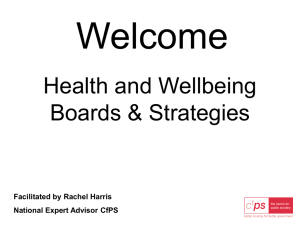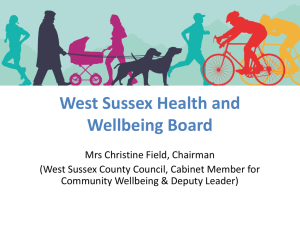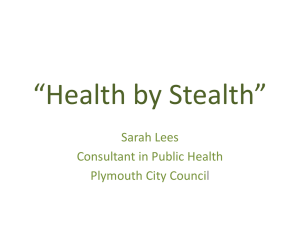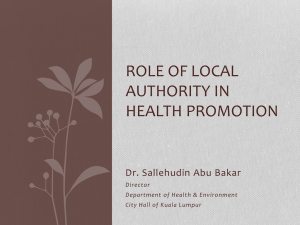Public Health and Local Government
advertisement
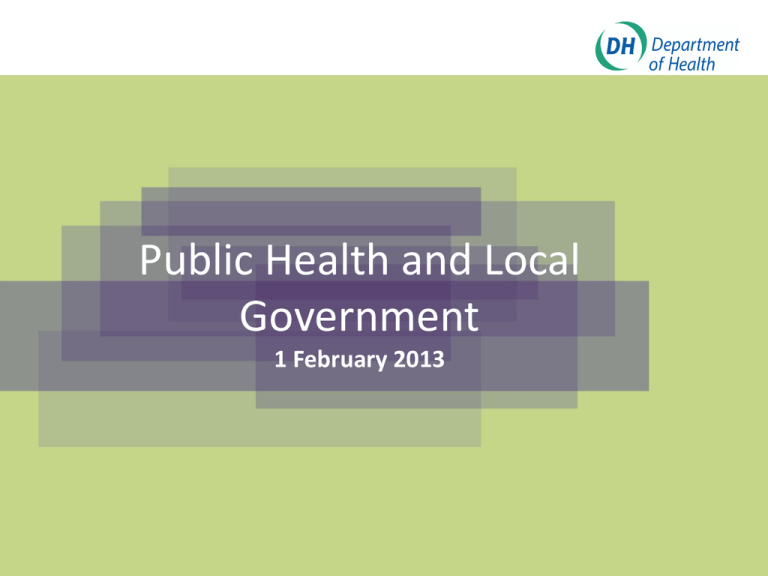
ClickPublic to edit Master style Health andtitle Local Government •Click to edit Master subtitle style 1 February 2013 Content • Public Health England Structures • Role of the Regions and Centres • Local Government Leadership for public health • Why District councils’ functions and relations make them vital partners for public health • Case Studies 2 Public Health England • • • • • • • Public Health England has been established to protect and improve the nation’s health and wellbeing, and to reduce inequalities. There is an intentional emphasis on professional health leadership through the appointment of three recognised leaders for health protection, health improvement and population health and a Chief Knowledge Officer. The health protection directorate will be responsible for health protection services, establishing and maintaining internationally benchmarked best practice. The health improvement and population health directorate will be responsible for the development of a 21st century health and wellbeing service, supporting local authorities and the NHS to deliver the greatest possible improvements in the public’s health. The knowledge and intelligence directorate will be responsible for the delivery of an internationally recognised, high-performing evidence and intelligence service encompassing research, statistics and know-how These three professionals will be complemented by a Chief Operating Officer, and directors for strategy, programmes, finance and corporate services, and human resources. For more information please see Structure of Public Health England Fact Sheet 3 PHE Regions • • • The effective delivery of Public Health England’s work will rely on joint action at a sub-national level. The agency will distribute a small number of its national office functions across four regions that are coterminous with those of the NHS Commissioning Board and the Department for Communities and Local Government’s resilience hubs. Public Health England’s regions will be focused on the effective functioning and professional development of the public health system, and assuring delivery in its local centres. Regions’ functions will be: • supporting transparency and accountability across the system, managing strategic discussions with partners including leaders in the NHS Commissioning Board, local government, Health Education England and others, in relation to the achievement of public health outcomes • providing professional support and leadership to the public health system including the joint appointment of directors of public health, clinical and medical supervision, and professional guidance and leadership • ensuring consistently high-quality services are provided by the agency’s centres, overseeing their contribution to improving health outcomes and in addressing local needs and priorities • ensuring the delivery of the national emergency planning, resilience and 4 response strategy across their region PHE Centres • • • • • Public Health England’s 15 centres will provide the organisation’s local presence and leadership. They will develop and maintain key relationships with local authorities, local resilience forums, the NHS and other partners to support and influence the delivery of improved outcomes for the public’s health. The centres will integrate the different public health disciplines, providing effective services and support for health protection, health improvement and health service public health. They will provide a single point of access to the full range of Public Health England’s specialist skills and knowledge. The centres will lead the delivery of the agency’s functions for their geographies, including: – – – – – – – building Public Health England’s relationship with local authorities and providing professional support to enable local authorities and other partners to maximise health improvement for their populations the provision of health protection services providing the local NHS with high- quality public health advice, including supporting the local director of public health in their relationship with the NHS employment and professional development of immunisation and screening teams integrated with the NHS Commissioning Board’s local area teams development of the specialist and wider public health workforce to support local authorities on public health workforce issues and managing Public Health England’s relationship with the local education and training boards provide public health specialists to support specialised commissioning and dental commissioning oversee delivery of drug and alcohol services, building on the role and structures of the National Treatment Agency for Substance Misuse 5 PHE local and regional support teams Local government leadership Local government should lead for public health because of its: • population focus, as the democratically accountable stewards of local health and wellbeing • role as the shapers of place • ability to address many of the wider social determinants of health, and • experience of, and ability to tackle, inequalities in health. 7 Environmental health • Enforcement of Health Protection Regulations, to prevent the spread of infection or contamination and cleanse property. • Health and Safety at Work Act enforcement, to require safety measures and if necessary prohibit the use of dangerous equipment and close down unsafe workplaces. • Official controls for food safety, to ensure good hygiene. • Environmental protection, to prevent pollution and require the clean-up of contaminated land. General environmental services • Monitoring air quality, indoor and outdoor, and enforcing pollution laws. • Tackling noise nuisance. • Bin collection, recycling, street cleaning, graffiti removal and maintenance of common spaces. Housing • Addressing homelessness, housing supply, affordable housing, supported housing and aids and adaptations, improving housing conditions, dealing with overcrowding, empty housing etc. Licensing • Licensing, for example of the sale of alcohol and tobacco and of taxis to protect the public, including young people. Physical activity and leisure • Leisure services designed to increase physical activity, including services designed with the involvement of disadvantaged and minority groups to help target health inequalities. • Targeted programmes to increase physical activity and improve health (eg exercise on prescription, health trainers). • Maintenance of playing fields, parks, open spaces, allotments. Planning • Planning for health, including issues of ‘liveability’, environments that facilitate physical activity, walking and cycling, access to community facilities, transport routes and employment. Addressing the wider determinants of health • Regeneration, supporting people into work, attracting new jobs and prosperity into areas. • Financial inclusion – revenue and benefits advice and access to affordable credit 8 Transformational opportunities from local authority leadership • Integrate services across health and more widely, eg education, housing, community safety • Develop new approaches to tackling major public health challenges – smoking, obesity, public health threats. • Greater influence on wider determinants of health – making health and wellbeing everybody’s business • Join up different local budgets to improve VFM & health e.g. Community Budgets • More local accountability and involvement of local people in shaping services = Better services + improved outcomes 9 Transitional work with Local Government • DH has worked very closely with local government so far, as well as with public health stakeholders. Good progress and engagement to date, reflecting enthusiasm from LG for role • Moving to a key stage in transition, with LG in lead, but central government still needing to be assured that system as a whole is ‘ready’ • PHE is developing its relationships with key stakeholders • We will continue to work closely with local government and public health stakeholders, to ensure the new system of public health achieve its aims of improving health outcomes for people and populations Web based resource ‘From Transition to transformation’ http://www.local.gov.uk/web/guest/media-centre//journal_content/56/10171/3374673/NEWS-TEMPLATE 10 Case Studies • Wychavon is one of six Worcestershire districts. It has a largely rural population. Wychavon recognises the cross-cutting nature of health and has integrated it into day-to day service delivery through Opportunity Vale of Evesham (OVE). This is a four-year project, funded through the county’s local strategic partnership, with a contribution from public health, and focusing on 11 of the most deprived areas in Wychavon district. Taking a broad approach to wellbeing, the overall project includes a variety of initiatives aimed at addressing community needs or remodelling services to be more responsive. The health improvement coordinator for the district council sits in the community development department and works with housing, regeneration, planning, environmental health, parks and strategy and communications sections of the council. Wychavon and the CCG are currently in the process of assessing and planning new approaches to health delivery in rural areas based on the learning from the Opportunity vale of Evesham Project. An example of this joint working to date has been a project with five GP practices referring COPD patients to the district council for energy improvement measures. 11 Case Studies • In Oxfordshire, as well as having a place on the health and wellbeing board, district councillors act as chair and vice-chair of the health improvement partnership board. This is a sub-group of the health and wellbeing board and will take forward traditional public health priorities as well as developing work around the broader determinants of health, including housing issues. Local authorities are exploring how to delegate funding which has traditionally supported housing initiatives to the health improvement partnership board. • In Lancashire a programme of councillor development in relation to the health reforms and health and wellbeing has been delivered across the two tiers of local government. A network of county and district cabinet members for health and wellbeing and another network for county and district lead officers for health and wellbeing have been established and are supported by Lancashire’s joint health unit. Co-production of public health support to district councils is led by the executive director of public health for central Lancashire. 12 Case Studies • Warwickshire’s shadow Health and Wellbeing Board includes three district councillors representing all five district councils together with any district council officers who wish to be ‘in attendance’ at meetings. The health and wellbeing board has deliberately sought to get district representation from housing, planning and environmental health within the district councils. A memorandum of understanding is being developed between public health and the five district/borough councils. Match-funding initiatives that focus on jointly agreed priorities are in place for 2012/13 and beyond. The public health budget will make up to £10,000 available for local initiatives in each district. • Derbyshire has had senior public health staff jointly appointed between the NHS and a number of the county’s eight district councils for several years, and many other staff devote some of their time to working in specific localities. District and borough public engagement mechanisms are an important source of health intelligence. Elected members of district councils are engaged with all the local partnership arrangements for health and wellbeing and there is also a well developed (although non statutory) health scrutiny function at district/borough level looking into issues such as carers, alcohol and young people and inequalities. 13 Case Studies • • Most districts councils in Lincolnshire have a health and wellbeing group which links to the health and wellbeing board. District councils and CCGs are now coming together for joint work, such as a joint project in East Lindsey with the British Heart Foundation, looking at reducing the incidence of coronary heart disease. A system of virtual public health networks has been developed in Leicestershire. The lead district council chief executive meets quarterly with the director of public health and the director of adult social services to develop shared approaches and strong networks. A senior public health specialist is co-located with district council staff for part of each week to develop strategic and operational approaches to health improvement and a system of small grants funding is devolved to individual districts. There are member health champions in each district who meet periodically with the chair of the health and wellbeing board, CCG senior managers and the director of public health to build understanding of the potential of the new system, develop skills and knowledge and look at locality priorities and delivery. The precise mechanisms for delivery are different in each district, (for example some have local health forums and some do not) and this flexibility is inherent in the model. 14 Conclusion • • • • • • District councils’ functions and relations with their communities make them vital partners for public health in two-tier areas. County councils can use the health reforms to review their public health governance and operational relationships with district councils and build on existing partnerships. In two-tier areas, there is a strong case for district councils to be represented on health and wellbeing boards, and in developing Joint Health and Wellbeing Strategies (JHWSs) (and associated action plans) as well as Joint Strategic Needs Assessments (JSNAs), to ensure that the assessment and strategies are sensitive to variations across the county. (Under the Health and Social Care Act 2012, district councils must be consulted on JSNAs, but not JHWSs although good practice indicates they should be consulted on both). Districts need to find a way of cooperating among themselves to develop and present a ‘district perspective’ and collective voice on health and wellbeing boards. Integration and joint working between district councils and clinical commissioning groups (CCGs) is as important as integration between county councils and CCGs – health and wellbeing boards will need to consider this when carrying out their statutory role in promoting integration. In many areas there is a third tier of local government. Parish and town councils have a role in community engagement and will need to be involved in developing JSNAs and JHWSs 15


